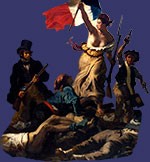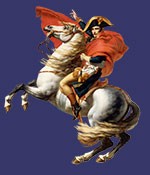
History of Paris
According to the archeological findings, the area around modern Paris was inhabited already in the Mesolithic period, since some remains of the early hunter-gatherer settlement were found in 2008. Other archeological findings testify that this area was also inhabited throughout the Neolithic period, the Bronze Age and the Early Iron age.
In the 3rd century BC, the Celtic Parisii tribe decided to settle here, on the banks of the river Seine, because here the river allowed the easiest crossing of its flow. They built the first fortress and bridges, therefore connecting the trade routes (that went from modern Great Britain to the Mediterranean area). Charging for crossing the river, the city prospered for a long time.
Between the 58BC and 53BC, the famous Gaius Julius Caesar (Roman general and politician) entered this territory under the pretext of protecting the Gallic population against the feared Germanic intrusions. Being weary of the Romans, the Gallic tribes, including Parisii, offered assistance to Caesar, but at the same time organized a union to fight him at the right moment.
After the Germanic intrusions were fought off, the Galls launched a rebellion against Caesar's dominion in 52BC, led by Vercingetorix. Caesar had decided to split his troops and send his deputy and a close friend Titus Labienus to Paris in order to deal with the unified Senon and Parisii tribes. With incredible ingenuity Titus managed to defeat the defenders and take over the settlement.
The city was romanised soon afterwards, meaning that a large Roman Forum was constructed, typical right angle streets, a Large Amphitheatre etc.
After the slow decline and the fall of the Western Roman Empire, the Franks tried to conquer the city. After a ten year siege Childeric, the king of the Franks, did not succeed to take over the city. However his son, Clovis I, managed to enter the city without fighting in 481AD. In 508, Clovis, the king of the Franks, made Paris the capital of his kingdom. However, in 751, the members of the new Frank dynasty moved the capital to Aachen (nowadays in Germany). In 987, a new dynasty is on the rise-the Capetian dynasty which would rule over France till 1848.
In the 14th century, the 100 years’ war broke out (between the Kingdom of France and England) and Paris was also hit by numerous plague outbreaks. During the first outbreak in 1348, around 50,000 inhabitants of Paris died and the plague continued to return to the city in 1360 and 1366. In 1418, the French lost Paris in the 100 years’ war and it took several decades for it to return under the French dominion in 1436.
 On July 11, 1789, a regiment of soldiers attacked peaceful demonstrations in Paris, which marked the beginning of the French Revolution. Several days later, the mob seized the arsenal at Invalides and attacked Bastille. Even though the revolutionists were able to get around 30,000 rifles from the arsenal, the gunpowder was moved to the Bastille several days earlier. The fortress was also a symbol of the royal authority and therefore an obvious target. The Bastille fortress was taken and completely demolished in the following few months. Fearing the counter attack, the revolutionists had barricaded the city and armed themselves as best as possible. Nevertheless, the counter attack never came, as King Luis XVI entered the city on July 17 in order to try the reconciliation with the people. Having realized that the revolutionists had success in Paris, the spirit of the revolution spread throughout the country, in which parallel institutions were created in numerous cities and the king of France slowly lost influence in the country. On October 5, 1789, a large crowd marched from Paris to Versailles and the next day brought the king and his family along with the government to Paris as prisoners. In 1792, Austria and Prussia declared war to France insisting on the return of the king. As a response to this, the revolutionist imprisoned king Luis XVI and his family. On September 21, 1792, the monarchy was abolished and France was declared a republic. The following year, on January 21, 1793, King Luis XVI was guillotined, while his wife Marie Antoinette met the same faith in October.
On July 11, 1789, a regiment of soldiers attacked peaceful demonstrations in Paris, which marked the beginning of the French Revolution. Several days later, the mob seized the arsenal at Invalides and attacked Bastille. Even though the revolutionists were able to get around 30,000 rifles from the arsenal, the gunpowder was moved to the Bastille several days earlier. The fortress was also a symbol of the royal authority and therefore an obvious target. The Bastille fortress was taken and completely demolished in the following few months. Fearing the counter attack, the revolutionists had barricaded the city and armed themselves as best as possible. Nevertheless, the counter attack never came, as King Luis XVI entered the city on July 17 in order to try the reconciliation with the people. Having realized that the revolutionists had success in Paris, the spirit of the revolution spread throughout the country, in which parallel institutions were created in numerous cities and the king of France slowly lost influence in the country. On October 5, 1789, a large crowd marched from Paris to Versailles and the next day brought the king and his family along with the government to Paris as prisoners. In 1792, Austria and Prussia declared war to France insisting on the return of the king. As a response to this, the revolutionist imprisoned king Luis XVI and his family. On September 21, 1792, the monarchy was abolished and France was declared a republic. The following year, on January 21, 1793, King Luis XVI was guillotined, while his wife Marie Antoinette met the same faith in October.
 After these events Paris fell to chaos, different political fraction fought for power, thousands of aristocrats and other “enemies” of the revolution were executed. Napoleon I brought stability to the city, made peace with the Catholic Church and re-established order. After becoming the Emperor, he begun large construction works in order to make Paris one of the most beautiful cities in the world. He order the construction of bridges, large city squares and numerous monuments, which are nowadays important tourist attractions of the city.
After these events Paris fell to chaos, different political fraction fought for power, thousands of aristocrats and other “enemies” of the revolution were executed. Napoleon I brought stability to the city, made peace with the Catholic Church and re-established order. After becoming the Emperor, he begun large construction works in order to make Paris one of the most beautiful cities in the world. He order the construction of bridges, large city squares and numerous monuments, which are nowadays important tourist attractions of the city.
After the defeat of Napoleon at Waterloo, the old monarchy was installed. The last monarch to rule over France was Louis Philippe. During his reign several revolts broke out that culminated with the one in 1848. Soldiers broke off the revolt, but instead of cheering him, many soldiers shouted “Long live the reforms”. Disappointed, the king abdicated and moved to England. Returning to the republic, the nephew of the Napoleon I, Louis Napoleon-Bonaparte, Napoleon III, became the first elected president of France.
During the First World War, German troops came close to Paris on two occasions. The distance was short enough to allow the bombardment of the city with long range artillery shells, first planes and zeppelins. On both occasions French troops, assisted by allies prevailed and Germans never entered the city.
However, German troops managed to enter Paris and to occupy the whole country during the Second World War. Germany attacked France on 10 May 1940, bypassed the heavily fortified area where the French government was expecting the attack to take place and headed towards Paris. First German troops entered the city on June 14. Adolf Hitler visited the city on June 24, the same year and visited the main tourist attractions. The Allies liberated Paris on August 25, 1944.
Did you know?
This is a complete tourist guide to Paris, France. We offer the up-to-date information as for what to visit and what to see in Paris. This information will help you get a bigger picture as regards tourist attractions this city has to offer. Paris is one of the most visited cities in the world and this fact stands to reason. Some of the much sought after tourist attractions are located here, such as for example the Eiffel Tower, the Triumphal Arch, Louvre Museum, Champs-Elysees Avenue, Orsay Museum or the famous Versailles Palace. Apart from these world-famous attractions, Paris is the city of love, the charm of which is almost irresistible to most visitors. If you are already in love, chances are that Paris will make you fall in love again, this time with the city itself.